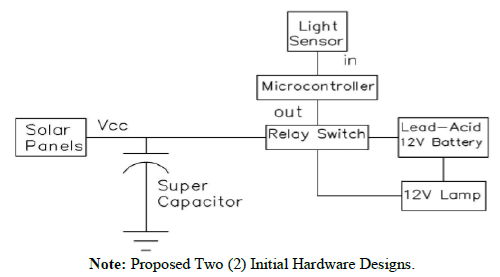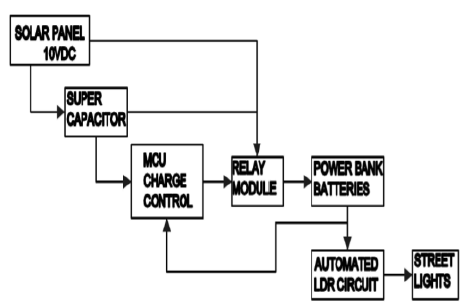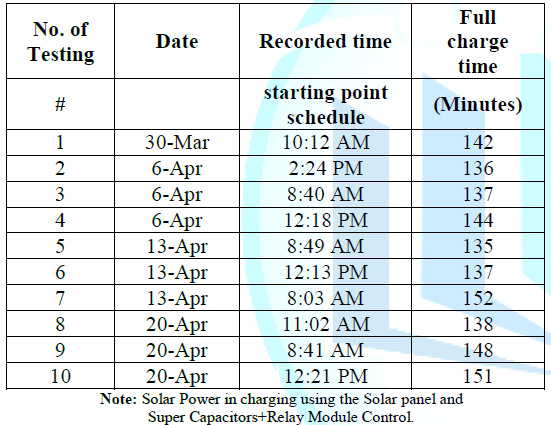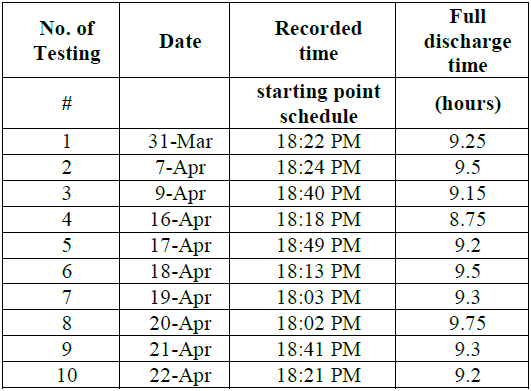Research Article :
Alvin T Dela Pena*,
Clarissa F Quezon and Christian Q Feliciano This descriptive study designed a prototype of the Automated
Solar Powered Street Lighting System with Super Capacitor that could be
installed in Colegio de San Juan de Letran-Bataan. It focused on the
development and the evaluation of a lighting system and a sensor device that
automatically lights up the lamp at night that can be used by the facility
monitoring and security purposes. The research project focused mainly on the
hardware assembly design and development of a street light which was powered up
by photovoltaic panels in which the electronic control and sensors for the
lightings effect is allotted for the components life span and battery
management [1]. It has the function of managing the solar energy harnessed from
the sun and converting it to an electrical energy by means of a photovoltaic
cell module [2]. The storage unit is enhanced through the aid of super
capacitors having its fast charging and discharging capability that will
support the loading system needed to the 12VDC lead-acid battery which will
provide the energy needed in the lighting system [3]. The researcher
implemented to use and install the street light at the school considering its geographical location on uplands or highlands
where it is more expose to sunlight and accumulates more energy during the
charging cycle. The device made might help to enhance the security monitoring
done by guards on duty at night by having a more visible environment through
this lighting system. The prototype of the automated street light was installed in the school where-in it expanded to continue the
previous study which is also an automated solar powered charging station for
mobile devices. This study is another application into the development of a
street light which basically charges and stores energy at daytime and utilizes
the stored energy by giving off light during nighttime. The electronic hardware
setup was designed to be a stand-alone system through solar energy to charge up
its own electrical energy into battery and capacitors while it also runs to
function simultaneously at daylight and to power up the LED lamp at night [4-7]. From the data gathered regarding the power consumption of
the institution, there is 20% increase in the electric bill consumption rate in
every 15% increase in the student s population from the previous years of 2016
and 2017 which is why the researcher came up to build a device that might
lessen the power consumption in the near future not only by supplying mobile
devices electrical
energy
through a charging station but also by using this automated solar powered
street lights instead of using grid connected street lights. An LED lamp was
used to sustain the lighting system which consumes less power and has a longer
life span [8,9]. The main problem of this study was to determine the building
process of the hardware design of an Automated
Solar
Powered Street Lighting System with Super Capacitor in Colegio de San Juan de
Letran-Bataan. Specifically, the study sought to answer the following
questions: ·
How to construct the hardware design using super capacitors,
battery and solar panel? ·
How to test and evaluate the functionality of the lighting
system in terms of its charging and discharging operations through the lamp? ·
How to create a charge controller for the storage unit and
light sensor device? This study was deemed significant to the following group/
individuals: School: By implementing this project study,
the cost of the electric bill might be decreased by using this device in
providing alternative source of renewable energy in illuminating the campus
especially at night. The proposed street light will be located at the
driveway/vicinity of Colegio de San Juan de Letran-Bataan. Facility, Auxiliary
Staff/Maintenance/Security OIC Personnel: A lighting/ illumination system
will be deployed in the vicinity of Colegio de San Juan de Letran-Bataan to
enhance the security and monitoring of its environment. This project may help the security
guards and the officer in charge for the surveillance and manual roving of the
campus by having a more visible sight at night. Researcher: The researcher expanded and
continued to develop a study about renewable energy sources and their knowledge
regarding their chosen field of expertise in electronics and also a project investment for
an alternative supply of energy and a lighting system off the grid that might
be visible in the market. Future Researcher: This case study will be an
essential reference, guide and related literature for providing consistent
information regarding the Automated Solar Powered Street Lighting System with
Super Capacitor and on the subject renewable alternative energy sources or the
related green energy project. This study used a descriptive design. A descriptive research
design is a type of research that defines relevant information from a
performance and situation of the test subject. An observation method was used
to achieve the data gathering from initial testing up to the implementation of
the study. This type of technique allows the researcher to record direct
measurements of the parameters involved from a current situation
such as the voltage and current that flows the system. The proponents collected data from the current hardware
design in terms of its full charging time and its full discharged time
operation at night to evaluate and display its descriptive statistics based
from the results obtained from the rest of the trials. Data specification of
hardware components, facts and literature were obtained also through secondary
sources such as websites, books, published and unpublished journals. They also
gathered data and relevant information from an interview to office
representatives in the institution regarding the electric bills and student
population [10] (Figure 1). Figure 1: Microcontroller set-up. Figure 2: Relay control set-up. The diagram above shows the second and final design of the
hardware design which was controlled by transistor switches which consumes less
power compared to the first set-up throughout the rest of the operation. This
design was fully implemented for the units of street light to be deployed
within the campus. A series of solar panels were combined to maximize the solar
energy absorption from daylight and the batteries will sustain the lighting
during night time [2]. The storage unit was managed by the charge controller
followed by a diode rectifier that allows the passage of current from the absorption
of the solar energy [1]. Presentation
of the Solution Installation of the Relay board
module as the Charge Controller: Technical Description: A Relay is a switch that
electrically operates an electromagnet. The electromagnet is activated with a small voltage
coming from the signal output of a circuit control and it pulls a contact to
make or break a direct current 12V. The source power will be activated or
triggered from the main circuit control giving command to the battery and the
lamp when to charge and operate continuously. The actual
appearance of the light sensor exposed at daylight and the schematic diagram
which shows the transistor switches which controls the activation of relay
switches to turn ON or OFF the LED light automatically coming from the
information sensed by the light dependent resistor as a sensor device [8]. The
relay switch here illustrates the direct connection of normally open (NO stands
for normally open) pole from the battery going to the lamp and when the sensor
detects darkness that will be the time when the open pole will be closed and
the battery will supply energy and power up the lamp and also this is the
actual appearance of transistor used for this control system. The sensor used has a function to activate the street lights
at night and to turn the lights off automatically at daylight. They are Light
Dependent Resistors (LDR) with sensitivity from daylight or any means of
lighting system [11]. This will be the main signal input needed for switching
purposes of the lighting system which are directly connected to bipolar
junction transistor (BC547) Darlington pair and the biasing technique applied
was an inverter switch that cuts off the voltage from a relay switch to the
source 12V voltage when daylight was sensed from the LDR. Lead acid 12V
batteries were used to supply energy for the lights on at night. The whole
storage capacity of the system was having a full charged voltage rate of 14.7 V
consumed for maximum of 8 hours average in all the trials recorded (Figure 3). Figure 3: The whole hardware circuit design. Capacitors where connected in series network 5 pieces 2.7V
500F each which amounts to a total of 18VDC when full charged and relayed
transferred to the 12V lead acid battery 400mAhr rate. It is possible to extend
its storage capacity intended also for functioning as a charging station for
mobile devices such as cellphones. It can manage the lack of solar light in 48
hours for totally draining the system without any support of charging straight
from the solar only just to support the loading system or lightings. The device consists of the 12V lamp which represents the
loading system of the street light, the concrete stand post which includes the
circuit box, 12V lead-acid battery and sensor for automatic lighting sequence
control of the lamp and the solar panel above the construction. An LED lamp
will be used to provide the illumination
system
which has a rate of ten to fifteen years life span with less power consumption
than traditional lightings [8]. The concrete box protects the circuit control
from dusts, dirt, rain, sunlight//heat and any other related factors that would
be a threat to the main control of the system device (Figure 4 and Table 1). The total cost of the material for one complete set up of a
street light is Php 7,250.00. In relation to its power consumption rate, a
single street lamp post consumes 0.32kWhr/month. Base from the computation
table of MERALCO, this consumption gains an amount of Php108.00 per month. Figure 4: Prototype construction Set-up. Table 1: Breakdown of the material cost. Taking into consideration the return of investment will be
attained in 68 months or in 5.6 years while the life span of the lighting
system can last for standard specification battery and components life of up to
fifteen years. MERALCO is an electrical power distributor in the Philippines
which is also known as Manila Electric Company. It is Metro Manila s only
electric power distributor and holds the power distribution franchise for 22
cities and 89 municipalities, including the whole of the National Capital
Region and the exurbs that form Mega Manila. By having Php108 X 12X5.6=Php, 7,257.00, which balances the
material costs of investment. To ensure reliability, the charging control
module unit will have a single module set up of the Relay module board to
automatically control the charging and discharging of the direct current full
load voltage from the super capacitor to the 12VDC battery. The source
input supply will be directly connected as the full amount of voltage that will
sustain the charging capability of the device into a maximum power transfer
from the solar panel to the external load street light LED lamp. Table 2: Accuracy test for charging the battery. According to the data given above (Table 2), the battery reached its full charge condition in an
average of 218.1 minutes using the solar panels alone for the rest of the ten trials. Table 3: Accuracy test for charging the super capacitors+battery. According to the data given above (Table 3), the battery reached its full charge condition at an
average of 155.6 Minutes for the rest of the ten trials which is faster than
the charging rate of the solar
panel
alone. Table 4: Accuracy test for charging the battery in aid of super
capacitor+relay module. According to the data given above (Table 4), the battery reached its full charge condition in an
average of one and a half hour using the solar panels with the combination of
stored accumulated energy from capacitors and the relay module for the rest of
the ten trials. Table 5: Accuracy Test for the discharge operation at night time of
the street light. According to the data given above (Table 5), the battery reached its full drain condition in an
average of 9.29 hours using the solar panels with the combination of stored
accumulated energy from the capacitors and the relay module for the rest of the
ten trials. In relation to the findings, the prototype was constructed with
super capacitors, solar panel, and a lead acid 12VDC battery to sustain a
stand-alone street light system which operates the entire cycle of its function
by generating its own energy and to supply power in the control. The relay
module was evaluated in terms of its operation of the charging sequence, the
automatic turning on and off of the lamp was performed also by the sensor and
the accuracy of the system was assessed through the result of its average value
for the charging time which is equal to 2.13 hours and its average value for
discharge time operation at night to light up the LED lamp is equal to 9.29
hours. By this study, we recommend that the street light and
charging station might be used for another application such as high voltage AC
output applications in supplying power for home appliances such us electric
fans for small scale applications only by expanding the solar panel array into
much higher voltages. In terms of the prototype installation, the hardware
construction built was made of concrete box, the circuit case might be improved
considering the structure, size and type of the battery and the type of
material to be use instead of a concrete structure for a better and easier
installation process. For alternative extensive design, the hardware to
generate electrical supply of energy might use wind turbine considering its
geographical location in high uplands. Automated Solar Powered Street Lighting System with Super Capacitors
Abstract
The researchers came up to conduct a study in
creating a street lighting system powered up by solar panels that sustains its
own power as a stand-alone system off the grid line. By analyzing the collected
data regarding the power consumption of the institution where in every 15%
increase in the student s population, there is 20% increase in the electric
bill consumption rate, that is why the researchers continue to expand their
previous study, the charging station that gives an alternative source of
electrical energy for mobile devices in the institution, to consider a free
energy that can be a source of light during night time, this may lessen the
power consumption in the near future not only by supplying mobile devices but
by also illuminating the environment of the campus. Two hardware designs were
constructed and tested as an initial hardware design to control the lighting
system namely; a microcontroller unit that will act as the charge controller
for the storage unit and a relay module using discrete components that will
also act with the same function. The study concluded that the installation of a
relay module alone as the charge controller to automatically cut-off the full
charge voltage and turn on the charging when voltage in the storage unit is
drain enhances the power management capability and storage of the lighting
system in comparison to the other design which consumes a greater amount of
power in operating the sensor control unit 24/7. The charging unit that uses
the super capacitors maximizes the charging time into an average of 136.567
minutes compared to the existing design that has twice of its charging time
condition which is equivalent to more than six(6) hours. The researchers
recommended that the Colegio de San Juan de Letran, Bataan should implement the
installation of this project study, or another study for improving the hardware
design components of the system which can be extended to the employees,
teachers and students of the institution.
Full-Text
Introduction
Statement
of the Problem
Significance
of the Study
Methodology

It shows the construction of the initial design with the aid
of a microcontroller to support the automatic charging cycle of the prototype
and also in activating the LED lamp [11]. The street lights operates
continuously from daylight due to its charging operation into its battery and
at nighttime to discharge the energy in sustaining the lighting (Figure 2).
Technical and Economic Study







Conclusion
Recommendations
References
Keywords
Photovoltaic cell, Super capacitor,
Microcontroller, Relay module and Charge controller.